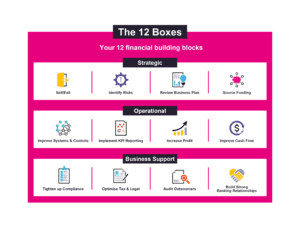
Succession planning and/or exit planning is a very common topic we encounter as CFO’s when addressing a client’s top list of priorities.
In fact, a current client of mine has listed this as their number one priority to be achieved over the next two years. “I want out in two years, and I want $xxxx!”
Business owners spend years building their businesses, nurturing, and developing them. For the most part, the very reason they started the business was inspired by a passion or an idea. Usually around a certain product or service that they felt could not only be a commercial success, but one that would make a difference.
Common Scenarios
A common scenario we encounter at the CFO Centre is a client up to their neck in meeting the day-to-day challenges of keeping the business “running smoothly”. They don’t have the time or wherewithal to put in place the mechanisms or strategies to set the business up for succession or exit.
In fact, we find the opposite. Business owners becoming so entwined in the business that they are involved in every aspect requiring their input. This makes the business impossible to feel separate as a stand alone entity, also making it even less attractive for a prospective purchaser.
Many business owners want that elusive buyer to walk through the door and offer a nice big settlement. The owner can then sail off into the sunset with a suitcase full of retirement cash.
This is not planning this is mostly wishful thinking. However, all is not lost and this is where we at the CFO Centre can help.
As I mentioned I currently have a client that wants to sell all or some of his business that he has built over the past twenty years. It is in manufacturing and in an industry that has its own set of unique challenges in terms of risk profile. So what can we do to assist?
Just like a real estate agent advising a client the things to put in place when selling a house, we can apply independence, objectivity, and non-emotional advice on how to position a business for sale.
Like anything that is worthwhile, setting up and executing the sale of a business or putting in place a successor takes time. Furthermore, this can take years to achieve. It is not a quick fix. Like a health check we need to implement the fundamentals that make a business successful and independent. Using our matrix of twelve financial building blocks we build the platform which enables you to ‘own’ rather than ‘run’ your business.
A more in-depth discussion can be had around our 12-box program but in essence they are:

The 12 boxes
Ideally, we address all operational issues first and foremost, in conjunction with our 4 boxes of business support. Implementing the 4 fundamental operational boxes sets up a healthy platform for the business. Therefore, making the business all that more appealing to a prospective buyer.
Once these are in place, we then transition into more of a strategic role. We can be that mind and voice of objectivity and independence. This is especially helpful in family companies whereby that non-biased voice of reason is so critical when making strategic decisions.
Here at the CFO Centre, we have an extensive network of affiliated partners. This includes business brokers, tax accountants, legal practitioners etc. This assists in providing great support under the business support matrix (above), together with our extensive network of CFO’s and their clients. Such a large business database is helpful when trying to attract interested parties for an owner motivated to sell. Never underestimate the power of our network.
There are other ways for an owner to exit other than a sale.
The most obvious being succession planning. Someone, or a group of employees within the organisation take over from you as the owner/operator. This does require years of training. Ideally one recruits or selects someone within the organisation that shows good leadership and management skills. Normally, this person will come with an entrenched set of skills – either sales/marketing, finance or operational. Whatever that skill base may be, one then needs to embark on a program of broadening these skills. They should encompass a good grounding in all key commercial disciplines – sales/marketing, finance and operations.
It is then critical to tie this person’s remuneration to the performance goals of the business. So when these are met, the individual concerned is rewarded – ideally through equity participation in the business. When I joined Australis Music back in 1996 as Finance Manager this was my exact path. Ultimately, I took over the CEO’s role from the Owner/Founder, Peter Hayward, in 2003. So, seven years of grooming and slowly handing the reigns. When Peter sadly passed away unexpectedly in 2006, he had done all things necessary to ensure that the company was in safe hands and that his largest asset was protected. I continued to oversee the company as CEO for three years after his passing, and ultimately sold the business to private equity.
The Moral?
The moral of this story – 7 years. 7 years it took to develop and execute the succession plan. By applying our 12 financial building boxes we can play a key role as your part time CFO. Assisting in the execution of your succession/exit plan. The key however this is a process and not a quick fix that can take years to implement.
Geoff Gazzard, CFO at the CFO Centre
Hire a superstar part-time CFO
To help you increase cash, profit and valuation and free you up from the burden of day-to-day operations.
